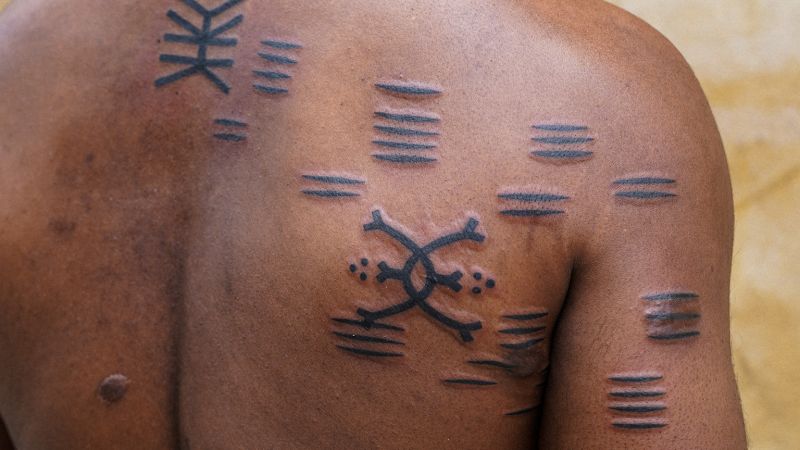Copyright Cable News Network

Emmanuel Item was first exposed to tattoo culture when he played guitar in a heavy metal band in Vienna. Item, who is of Nigerian and Austrian descent, already liked to draw in sketch pads, but after seeing a band member tattooed with the head of Hindu elephant-deity Ganesha, he decided to take his art from paper to skin. That decision paid off. A decade later, he has tattooed more than 500 people with designs that draw deeply on his Nigerian heritage, and at the end of October, his work was recognized with the award of an artist residency in Vienna, run by the African Cultural Foundation. Connecting to roots After he first decided to work with tattoos, the then 19-year-old began researching the origin of body art — which led him to the traditional imagery used by Nigeria’s Igbo people. “That was how I came across Uli and Nsibidi designs,” said Item, now 30. “This discovery also answered my desire to connect to my roots, through my art.” Uli consists of curves, lines and abstract forms drawn on the body or as murals. It originated in eastern Nigeria and traditionally, women were the Uli artists, adorning one another with the intricate designs using dye extracted from plants. Nsibidi is a writing system that dates back hundreds of years and originated in the Cross River State in southern Nigeria and in Cameroon. It inspired one of the written languages in 2018’s “Black Panther” movie. Iheanyi Igboko is executive director of the Centre for Memories in Enugu, Nigeria, which is dedicated to documenting and showcasing Igbo history and culture. He told CNN that Uli and Nsibidi “exemplify a convergence of art, identity and socio-cultural meaning within their respective societies.” Igboko explained that Uli murals also appeared on shrines dedicated to Ala (the Igbo Earth goddess), reinforcing the connection between art, spirituality and environmental harmony. Uli declined during the colonial period but has undergone significant revitalization in contemporary Nigerian art. He added that Nsibidi operates primarily as a graphic system of communication rather than a decorative art form. It was closely associated with the Ekpe (leopard) secret society, where members used it to execute laws, for social regulations, ritual communications, and historical record-keeping. Along with Uli, Nsibidi began declining in Nigeria with the introduction of Christianity in colonial times and the imposition of Western education. Keen to learn more about these forms, Item began an annual visit with his father to his ancestral village of Afikpo, in Nigeria’s eastern Ebonyi State. “I sought visuals I could infuse into my work from traditional fabrics, architecture and traditional tattoos,” he said. “I try to understand the reason behind the lines, stars, curves, motifs and the overall appearances of the designs. I then create mine from the knowledge I garner, in contemporary form, using more lines and geometry.” “A living archive” With his newfound knowledge, back in Vienna, Item began reviving these art forms by using them as inspiration for tattoos, helping people of African heritage connect to their roots. “Some of them have never been to Africa, so they look for some kind of meaningful connection to their own culture,” he explains. “Others have been away for long and the tattoos are another way of reconnecting there.” Igboko describes Item’s work as transforming the human body into a living archive: a site of memory and identity. “At the center, our motto is ‘Maka ụnyaa, taa na echi’ (for yesterday, today, and tomorrow), and Item’s work speaks directly to that,” he said. “Each tattoo becomes a personal yet communal statement, reconnecting people, particularly those in the diaspora, with the philosophies and aesthetics of their heritage. His art moves beyond decoration; it becomes a form of storytelling and cultural continuity.” Item has created almost 100 designs of his own and his work continues to evolve as he incorporates elements from across West Africa, including designs from Ivory Coast’s hand-painted Korhogo cloth, which infuses figurative motifs with intricate patterns. His long-term goal is to start a hub in Vienna where people can learn more about Africa through tattoos, books and art. “I want Africans in the diaspora to be able to have a place to where they connect with their roots,” Item said. Item’s residency with five other BIPoC (Black, Indigenous, and people of color) artists runs from November 1 to December 31 2025, at the NIA Empowerment Space, Vienna, where he will work and share his practice.



